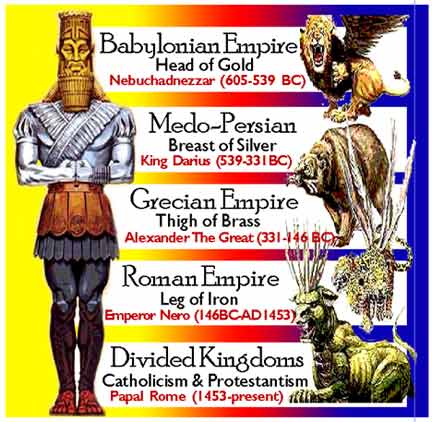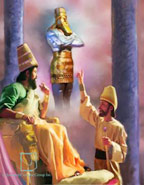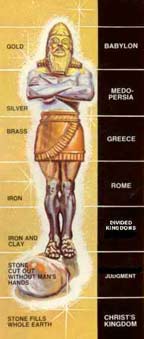Daniel's "Seventy Weeks" pertains to Daniel’s vision of what was going to transpire in Israel for 490 years from their release out of Babylonian captivity to the going forth of the commandment that will cause the Jews to return to build back the holy city of Jerusalem.
Because
of Israel’s apostasy, the prophet Jeremiah had foretold that the Jews
would be delivered as captives to Babylon. In that foreign land they would
be confined for seventy years (Jeremiah 25:12; 29:10).
Sure enough, this prophet’s warnings proved accurate. The general
period of the Babylonian confinement was seventy years (Daniel 9:2; 2 Chronicles
36:21; Zechariah 1:12; 7:5).
THE PROPHECY
The content of that prophecy, as recorded in Daniel 9:24-27, is as follows:
24 - Seventy weeks are determined upon thy people and upon thy holy city, to finish the transgression, and to make an end of sins, and to make reconciliation for iniquity, and to bring in everlasting righteousness, and to seal up the vision and prophecy, and to anoint the most Holy.
25 - Know therefore and understand, that from the going forth of the commandment to restore and to build Jerusalem unto the Messiah the Prince shall be seven weeks, and threescore and two weeks: the street shall be built again, and the wall, even in troublous times.
26 - And after threescore and two weeks shall Messiah be cut
off, but not for himself: and the people of the prince
that shall come shall destroy the city and the sanctuary; and the
end thereof shall be with a flood, and unto the end of the war desolations
are determined.
27- And he shall confirm the covenant with many for one
week: and in the midst of the week he shall cause the sacrifice and the
oblation to cease, and for the overspreading of abominations he shall make
it desolate, even until the consummation, and that determined shall be poured
upon the desolate.

From a study
of Jeremiah's prophecy, Daniel had calculated that the time of Israel's
captivity which is seventy years was about to end (Daniel 9:1-2). The year
that this vision came to him was approximately in 538 BC.
They went into captivity in the year 606 B.C. And counting 538 from
606 is 68 years.
HISTORICAL CONTEXT
The 70 year exile to Babylon was about complete as Daniel had discerned
from reading Jeremiah's prophecy (Dan. 9:2). He was in prayer about the
future of his people because it was their sin and transgression towards
God that had sent them into exile. While in prayer, Daniel was visited by
the angel Gabriel who had been sent by God to give him "insight and
understanding" (Dan. 9:22) regarding a "70 week" program
for his people and his holy city (Dan. 9:24-25). Gabriel revealed the events
to Daniel all the way until the Kingdom was completely restored and the
Millennium set in upon the earth. Upon completion of the 70th week, Israel's
"transgression" would be finished, her "sin" ended and
her "iniquity" would be atoned for.
The law of Moses had commanded the Israelites to acknowledge every seventh
year as a sabbatical year. In the first year of Darius, who had been appointed
king over the realm of the Chaldeans (c. 538 B.C.), Daniel, reflecting upon
the time-span suggested by Jeremiah’s prophecies, calculated that
the captivity period almost was over (9:1-2). He thus approached Jehovah
in prayer. The prophet confessed his sins, and those of the nation as well.
He petitioned Jehovah to turn away His wrath from Jerusalem, and permit
the temple to be rebuilt (9:16-17).
The Lord responded to Daniel’s prayer in a message delivered by the
angel Gabriel (9:24-27) saying that the house of God would be rebuilt. A
more significant blessing would come, however, in the Person of the Anointed
One (Christ), Who is greater than the temple (cf. Matthew 12:6).
THE SUBJECTS OF THE PROPHECY
There can be no question about the identity of the subjects of Daniel's prophecy: it concerns the nation of Israel, those for whom he had been praying in their captivity, and Jerusalem, their capital city.
Daniel had been pondering the future of his people, and in the writings of Jeremiah he found a partial answer: they would soon be delivered. His subsequent prayer for their deliverance from captivity was interrupted by Gabriel who informed him of still more details of his nation's future--specifically, a period of 490 years.
In the introduction to the prophecy, Gabriel speaks of "your people and your holy city" and of "the holy of holies", which is clearly and always in the Old Testament a reference to Israel's tabernacle or temple. The prophecy throughout employs such terms as "Jerusalem," "the city," and the "the sacrifice and the oblation." The people and city under discussion could not be made more obvious; namely, the nation Israel and her capital city, Jerusalem.
THE OBJECTIVES OF THE SEVENTY WEEKS
By the use of a series of categorical phrases in verse 24, it states
the six-fold purpose of these seventy weeks: "(1) to bring transgression
to an end, and (2) to make an end for sin, and (3) to make reconciliation
for iniquity, and (4) to bring in everlasting righteousness, and (5) to
seal up the vision and prophesy, and (6) to anoint the most Holy."
This context sets forth the primary purpose of Jesus Christ’s mission
to Earth. First, the Messiah would come to deal with the problem of human
sin. He would “finish transgression,” make an “end of
sins,” and effect “reconciliation for iniquity.” That
theme is developed gloriously throughout the New Testament (Read Matthew
1:21; 20:28; 26:28; 1 Corinthians 15:3; 2 Corinthians 5:21; Galatians 1:4;
Ephesians 1:7; Colossians 1:20; 1 Peter 2:24; Revelation 1:5).
DANIEL'S Seventy Weeks, which are equal to 490 years, are scripturally divided
into three periods: first, into a period of "Seven
Weeks; "secondly, of " Sixty Two Weeks;
"and thirdly, of "One Week."
The commencement of the Seventy Weeks and of the Seven Weeks, are the same.
Both periods began at "the going forth of a commandment causing to
return and to build Jerusalem," eighty-three years after the end of
the seventy years Babylonian captivity. This imperial decree of the Persian
king was the official restoration of the Commonwealth of Israel, at present
in continuity "until the times of the restitution of all things which
the Deity hath spoken by the mouth of all His holy prophets," from
the beginning of the Mosaic Economy (Acts 3:21,) and until He shall send
Jesus Christ to "raise up, or build again the Tabernacle of David,"
that is fallen, and close up the breaches thereof: and to set it up as in
the days of old.(Acts 15:16 ; Amos 9:11).
THE PROPHETIC CHRONOLOGY
The time element of this famous prophecy enabled the studious Hebrew to
know when the promised Messiah would die for the sins of humanity. The
chronology of this prophetic context involves three things: (a) a commencement
point; (b) a duration period; and (c) a concluding event.
The beginning point was to coincide with a command to “restore and
rebuild Jerusalem.” The time span between the starting point and the
concluding event was specified as “seventy weeks.” This would
be seventy weeks of seven days each — a total of 490 days. Each day
was to represent a year in prophetic history. It was a symbolism denoting
a period of approximately 490 years. Each week meant seven years. One
week is equal to seven years.
The terminal event of this time frame would be the “cutting
off,” (the death) of the Anointed One (9:26) in the midst of the seventieth
week. Actually, the chronology is divided into three segments,
the total of which represents 486½ years. This would be the span
between the command to restore Jerusalem, and the Messiah’s death.
If one is able to determine the date of the commencement point of this prophecy,
it then becomes a relatively simple matter to add to that the time-duration
specified in the text, thus concluding the precise time when the Lord was
to be slain.
In computing the dates, it is important to base our computation
upon the original Hebrew calendar which has 30 days in every month.
We have had three different calendars. In the old astronomy calendar, which
is the Julian calendar, there are 365 1/4
day in a year. In the Roman calendar that we live under
now, there are 365 days in a year by our calendar. But
in the Christian or prophetic calendar we find that there
is only 360 days in a year. The Bible said that they prophesied one thousand two hundred and threescore days. Now, if we
take the astronomy calendar, it would sure miss it a long ways from being
three and one-half years. The Roman calendar is also inconsistent because
it has 30, 31 and even 29 days in some of its months and therefore can not
be relied upon. If we take the Roman calendar that we have today, it would
miss it a long ways. But if you take the prophetic calendar, there's
exactly one thousand two hundred and threescore days in thirty days to the
month.
THE COMING OF THE PRINCE
The going forth of the commandment to rebuild Jerusalem, according to Brother Branham, was on the 14th day of March which in the Hebrew it is called Nisan, which means "March." The issue was given on the 14th day of March, B.C. 445. Here is what he taught us in His sermon the SEVENTY.WEEKS.OF.DANIEL 08-06-1961:
”Now,
Jesus, the Messiah, rode into the city of Jerusalem, on the back of a white
mule on Palm Sunday, April the 2nd, A.D. 30. And
now, from B.C. 445 to A.D. 30 is exactly 475 years. But as we have already
seen that the sixty-nine weeks makes 483 years... Now, there's where the
trouble comes, right there. See? We've got only with the marking of the
Bible here, time, only 475 years, and actually it's 483 years, a difference
of eight years… Now, the B.C. 475 to A.D. 30 are Julian or astronomy
years, which are 365 1/4 day in each. But when we reduce them days to our
prophetic calendar... Our prophetic calendar brings us to 360 days
as we use now in the Scriptures. We have exactly 483 (There it
is.)--483. Here we have exactly proof of the prophecy, exactly the truth.
For from the time of the going forth to build the temple until the destroying...
Or when they rejected Christ and killed Him in A.D. 33--when Christ was
killed is exactly 483 years. Now, from the going forth of the commandment
to rebuild Jerusalem was determined seven weeks, which meant forty-nine
years, and forty-nine years hit it exactly.”
It is in “the midst” of the seventieth week, after the fulfillment
of the 486½ years, that the Anointed One was to be “cut off.”
This is a clear reference to ACTUAL TIME of the death of our Lord Jesus
Christ. Isaiah similarly foretold that Christ would be “cut off out
of the land of the living” (Isaiah 53:8).
THREE SEGMENTS
The “seventy weeks” of Daniel’s prophecy are divided
into three segments — (1)seven weeks, (2)
62 weeks, and (3) the “midst” of one week (70th).
1. The first division of “seven weeks” (literally, forty-nine years) covers that period of time during which
the actual rebuilding of Jerusalem would be underway, following the Hebrews’
return to Palestine (9:25b). This was the answer to Daniel’s prayer
(9:16). That reconstruction era was to be one of “troublous times.”
The Jews’ enemies had harassed them in earlier days (see Ezra 4:1-6),
and they continued to do so in the time of Ezra and Nehemiah.
2. The second segment of sixty-two weeks (434 years), when
added to the previous forty-nine, yields a total of 483 years. When this
figure is computed from 457 B.C., using the Hebrew Calendar, it terminates
at A.D. 30. This was the year of Jesus’ baptism and the beginning
of His public ministry.
3. Finally, the “midst of the week” (3½ years) reflects
the time of the Lord’s preaching ministry. This segment of
the prophecy concludes in A.D. 33 — the year of the Savior’s
death.
It is now clear that the First half of the SEVENTIETH WEEK of Daniel pertained
to the 3 ½ years ministry of Jesus Christ on earth from the day of
His Water Baptism at the River Jordan till his death in 33 ½ A.D.
This fulfilled the verses “And after threescore and two weeks shall
Messiah be cut off”.
------- QUOTATIONS ON FIRST AND LAST 3 AND 1/2 YEARS ------
QUESTIONS.AND.ANSWERS.ON.THE.SEALS_ JEFF.IN SUNDAY_ 63-0324M
35. Brother Branham, I noticed you--your referring to Daniel's seventy weeks on the First Seal message. I understand on Daniel--on the tape of Daniel when the Gospel returns to the Jews, the seventy weeks will begin. Is there a one seventy--one week, seven years, left for the Jews, or yet is there only one-half week, one three and one-half years left for them?
Answer: Only one-half week: Jesus prophesied the first half week, as was predicted, only one-half week left for them.
*****************************************************************************************
THE.EVENING.MESSENGER_ MESA.AZ V-8 N-5 WEDNESDAY_ 63-0116
132 Notice, if the Gentile church has to be taken away first, for the Jews, then the end of the Seventy weeks of Daniel takes place. The three and a half years Messiah prophesied, and then He was cut off, the Prince, in the middle of the seventieth week. And, then, there's three and a half weeks left yet. And we find out two prophets of Revelation (He never changes His coat again.), of Revelations 11, comes down and prophesies to the Jews. Now, the Church will be taken away at that time.
************************************************************************************
QUESTIONS.AND.ANSWERS.3_ JEFF.IN COD SUNDAY_ 64-0830M
371. Since then, it seems like the first three and one half years was fulfilled during the ministry (Well, here you've got it right here.) of--of Jesus, but the expression, "midst of the weeks" seems to be applied only to the antichrist breaking his covenant with the... (No, that antichrist breaks his covenant at the end of the last three and one half years. See?) As I understood Daniel tape, the first sixty-nine weeks ended when Jesus rode into Jerusalem A. D. 30, so that three and one half years of His ministry would be included in the sixty-nine week's; and the full last weeks--and the full last week or seven years would still be fulfilled and would begin at the rapture. Please clarify this for me.
You know, brother, sister, ever who it is that's asked this question. Very fine (See?), but I believe you got a little mixed up on what I said. See? Now, the--when Jesus came into Jerusalem (That is exactly right.), that was the end of... See? He went right straight in from there and was crucified. See? And He--He did prophesy half of the seventy weeks which is three and one half. Now, He was cut off, and His soul was made a sacrifice. And now, there would come then... In this last days, there's three and one half years still promised to the--the Jews. And the--in--during this time was a gathering up of the saints for the rapture, the church.
********************************************************************************************
THE PEOPLE OF THE PRINCE WHO WILL DESTROY THE CITY
No historical revisionism can alter the fact that the Lord Jesus was put to death by His own people, the Jews (John 1:11). This does not sanction any modern-day mistreatment of the Jewish people; it does, however, acknowledge that Israel, as a nation, suffered a serious consequence as a result of its role in the death of the Messiah.
Daniel’s
prophecy depicted the Roman invasion of the city Jerusalem by Titus, the
Roman General, who was in-charge of the destruction of the Jewish temple. The prophet spoke of a certain “prince that shall come,”
who would “destroy the city and the sanctuary” like an overwhelming
flood (9:26b). All of this was “determined” (see 9:26b, 9:27b)
by God because of the Jews’ rejection of His Son (Matthew 21:37-41;
22:1-7).
When the Messiah was cut off, God ceased to deal with the Jews. They did
not go any farther. They were then scattered by the Roman Empire. Time extended
out a little bit farther. God wasn't dealing with the Jews anymore. He only
dealt with them until they rejected Christ. When they crucified Christ,
and they cried, "Let His blood be upon us and our children!" and
it's been over ever since.
God has failed to deal with them anymore. God then went dealing with the Gentiles which started the advent of the “Seven Church Ages”, wherein God was taking a Gentile Bride for His Son Jesus Christ, by sending seven messengers to the seven church ages to call out a Bride. God has quit dealing with the Jews right there, because God always deals with Israel as a nation. Israel is a nation. Gentiles are a people. And He had to take a people out of the Gentiles for His Name. This was the “gap” between the first part and the last part of the SEVENTIETH WEEK of Daniel, which is 3 ½ years on both ends. Paul made it clear in ROMANS 11:25-26: “For I would not, brethren, that ye should be ignorant of this mystery, lest ye should be wise in your own conceits; that blindness in part is happened to Israel, until the fulness of the Gentiles be come in. And so all Israel shall be saved: as it is written, There shall come out of Sion the Deliverer, and shall turn away ungodliness from Jacob.”
THE REMAINING HALF OF THE SEVENTIETH WEEK
Once the seven Gentile Church Ages are over and the Gentile Bride caught away in the rapture, the remaining 3 ½ years of the Seventieth Week of Daniel will resume back to Israel for God will call Israel to the Feast of Atonement. This pertains to the verse “to make reconciliation for iniquity, and to bring in everlasting righteousness”.
Two prophets, Moses and Elijah, will call out and minister to 144,000 Jews, during the Tribulation period, as prophesied in Revelation 11:3-6:
“ And I will give [power] unto my two witnesses, and they shall prophesy a thousand two hundred [and] threescore days, clothed in sackcloth. These are the two olive trees, and the two candlesticks standing before the God of the earth. And if any man will hurt them, fire proceedeth out of their mouth, and devoureth their enemies: and if any man will hurt them, he must in this manner be killed. These have power to shut heaven, that it rain not in the days of their prophecy (Elijah): and have power over waters to turn them to blood (Moses), and to smite the earth with all plagues, as often as they will.”
Moses symbolizes the law, and Elijah symbolizes the prophets. These two witnesses comes back to Israel to introduce them back to the true Messiah and to seal all the elect Jews back to receiving Jesus Christ, their elder brother.
THE
144,000 JEWS
As Joseph in the Old Testament revealed Himself to his brethren, so will
Jesus reveal Himself to His Jewish brethren who have sold him wand betrayed
him. As this scenario takes place, it is also during this time that Tribulation
Period is going-on. REVELATION 7:4-8 talks about this prophesy:
“And I heard the number of them which were sealed: [and there were] sealed an hundred [and] forty [and] four thousand of all the tribes of the children of Israel. Of the tribe of Juda [were] sealed twelve thousand. Of the tribe of Reuben [were] sealed twelve thousand. Of the tribe of Gad [were] sealed twelve thousand. Of the tribe of Aser [were] sealed twelve thousand. Of the tribe of Nepthalim [were] sealed twelve thousand. Of the tribe of Manasses [were] sealed twelve thousand. Of the tribe of Simeon [were] sealed twelve thousand. Of the tribe of Levi [were] sealed twelve thousand. Of the tribe of Issachar [were] sealed twelve thousand. Of the tribe of Zabulon [were] sealed twelve thousand. Of the tribe of Joseph [were] sealed twelve thousand. Of the tribe of Benjamin [were] sealed twelve thousand.”
Getting
back to the story of Joseph meeting his brethren, we will recall that not
all the brethren came. Joseph knew that and insisted that all the brethren
appear before him, or he could not make himself known unto them. Finally
they brought the one that was missing, little Benjamin. It was little
Benjamin, the full brother of Joseph, that set his soul on fire. And when
our Joseph, even Jesus, will come to the people who have kept the commandments
of God and who have gone back to Palestine, His soul will be set on fire.
Little Benjamin typifies the 144,000 Israelites from all over the earth
who have gone back to Palestine for their redemption.
They will be standing there ready to receive Him, Whom to know
aright is Life eternal. They will say, "This is our God for Whom we
have waited." Then they will see Him Whom they have pierced.
And they will cry out in dismay, "Where did these awful wounds come
from? How did it happen?" And they will wail and cry, every family
apart, everyone apart in the agony of sorrow.
Now where will the Gentile Church be while Jesus is making Himself
known to His brethren? Remember that the bride of Joseph with the
two children were in the palace, for Joseph had commanded, "Let everyone
leave me; put them all out from before me." So the Gentile bride was
hidden in the palace of Joseph. Where will the Gentile Church go
in the rapture? Into the palace. The bride will be taken off the earth.
She will be caught up before the great tribulation to meet her Lord in the
air. For three and one-half years while the retributive wrath of God is
poured out, she will be in the great Marriage Supper of the Lamb.
Then will He return, leaving His bride in "His Father's house,"
while he makes Himself known to His brethren. At this very time,
the antichrist covenant that the Jews have made with Rome will be broken.
Rome and her allies then send their troops to destroy all the God-fearing,
Word-abiding Jews (Daniel 9:27).
But as they come against the city to destroy it, there will appear in the
heavens the sign of the coming of the Son of Man with His mighty armies
to destroy them who have been destroying the earth. With the enemy repulsed,
Jesus then comes and presents Himself to the 144,000. Having seen His mighty
acts of salvation, they have come to know His power. But also seeing His
wounds and knowing that they had rejected Him even to that moment, causes
them to cry out in the agony of terror and fear, even as did their brethren
of old when they stood before Joseph, being sore afraid that they would
be killed. But as Joseph said, "Don't be angry with yourselves. It
is all right. God was in it all. He did it to preserve life." Even
so will Jesus speak peace and love to them.
Why
did the Jews reject Jesus? God was in it all. It was the only way that He
could bring out the Gentile bride. He died on the cross to preserve the
life of the Gentile Church.
Now these 144,000 are not in the bride. In Revelation
14:4 they are called virgins and they follow the Lamb whithersoever
He goeth. The fact that they have not defiled themselves with women shows
that they are eunuchs (Matthew 19:12). The eunuchs
were the keepers of the bridal chambers. They were attendants.
Notice that they do not sit in the throne but are before the throne. No,
they are not in the bride, but will be in the glorious millennial reign.”
And
immediately after his days shall the great tribulation set in and burn the
earth. And then at the return of the church and the Bride, the
Bride and Christ shall walk out upon their ashes in the millennium, when
the earth is purified by fire. And there they shall reign. And the heathens
that's never heard the Gospel shall be raised in that time, and the sons
of God will be manifested. If he's to reign, he's got to have something
to reign over; he's got a domain. "And they ruled and reigned with
Christ," and Christ ruled with a rod of iron the nations. Then the
Gospel... Then the manifested sons of God with the authority just like He
had when He was here (See?), there will come the millennium in that reign
(See?), upon the ashes.



